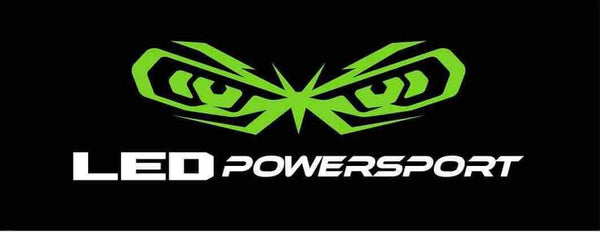
Snowmobile Night Riding Safety Tips: How Better LED Headlights Keep You Safe After Dark
Share
Snowmobile Night Riding Safety Tips: How to See Better, Ride Safer, and Avoid Trail Hazards
Riding at night can be one of the best parts of snowmobiling — fresh powder, empty trails, and crisp cold air. But it’s also when visibility drops, temperatures crash fast, and mistakes become dangerous. As a Minnesota-based brand that specializes in snowmobile LED headlights, we’ve spent years helping riders see farther, react faster, and stay safer after dark.
This guide covers the most important night riding safety tips — including real-world advice from LEDPowersport™ owner and rider Dustin Maurer — plus the lighting upgrades that make the biggest difference in low-visibility conditions.
For riders wanting long-range visibility this season, explore our full lineup here:
LEDPowersport™ Snowmobile LED Headlights
1. Upgrade Your Headlights for Maximum Night Visibility
The #1 safety upgrade for night riding is improving your lighting. Stock halogen bulbs fade quickly, scatter against snow dust, and don’t project far enough on long straightaways. High-performance LEDs provide:
- Longer throw distance to spot corners earlier
- Clear white light that cuts through snow dust
- Better depth perception in woods and powder
- Instant full brightness even in sub-zero temperatures
If you ride in deep snow, on lakes, or at higher speeds, a focused LED beam helps prevent “overdriving” your headlights — when your stopping distance exceeds what your lights can illuminate.
See our highest-performing setup here:
130W High Power Series LED Headlight Kit
2. Always Ride with a Buddy (Real-World Tip from Owner Dustin Maurer)
“Always ride with a buddy! A breakdown alone in the dark isn’t just not fun — it can be dangerous. Especially if you don’t have cell service and it gets colder at night.” — Dustin Maurer, LEDPowersport™ Owner
Night riding increases the odds of:
- Mechanical issues you can’t see coming
- Sudden ice patches
- Missed turns or low-visibility hazards
- Frostbite or hypothermia if stranded alone
3. Do a Quick Pre-Ride Safety Check Before Every Night Ride
Dustin recommends performing a fast “once-over” on your sled before heading out — even if you rode earlier the same day.
- Check fuel level
- Check oil level (especially on 4-strokes)
- Inspect idler wheels and suspension
- Check front and rear shocks
- Tighten skid bolts
- Inspect the clutch area
- Confirm your headlights and taillights work properly
A 30-second inspection can prevent a long cold walk home.
4. Keep Your Cell Phone Charged — and Warm
Phone batteries can die in minutes at -10°F to -20°F, especially when exposed to cold wind or stored in an outside pocket. A dead phone means:
- No GPS
- No emergency calls
- No way to contact your riding buddy
Keep your phone in an inside chest pocket, close to your body heat. Dustin recommends making sure it’s 100% charged before you ride.
5. Pack Water, Sports Drinks, and Snacks in Case of Emergency
Dehydration happens even in cold weather — faster than most riders think. If you break down away from town or have a long wait for help, having:
- A bottle of water or electrolyte drink
- A couple granola bars or high-calorie snacks
…can make a huge difference in comfort and safety.
6. Understand Your Sled’s Electrical System (AC vs. DC Power)
Not sure whether your machine runs AC or DC power? That determines whether you need a rectifier when upgrading to LEDs.
If you ride Arctic Cat or Polaris, many models run AC — which requires a rectifier to protect your LEDs and prevent flickering.
Follow the full guide here:
How to Tell if Your Snowmobile Has AC or DC Power
7. Choose the Right LED Bulb Type for Your Sled
Different sleds use different bulbs — H4, H13, 880/881, etc. Using the wrong type can cause dim beams or overheating.
If you’re unsure, you can always ask for help or use our fitment check page.
8. Avoid Overdriving Your Headlights
Overdriving happens when you’re riding faster than your lights can illuminate the trail ahead. This is a leading cause of night riding accidents.
Upgrading to high-power LEDs increases safe visibility distance — giving you time to react to:
- Downed trees
- Sweeper corners
- Trail washouts
- Wildlife crossing
If you want maximum reach at night, start with your headlights:
Shop Snowmobile LED Headlights
Conclusion
Night riding is one of the best parts of winter — as long as you’re prepared. Better lights, a quick safety check, a riding buddy, and basic supplies make every after-dark ride safer and more enjoyable.
When you’re ready to upgrade your visibility this season, explore the complete LEDPowersport™ lineup:
LEDPowersport™ Snowmobile LED Headlights
Frequently Asked Questions
Are LED headlights better for night riding?
Yes. LEDs provide clearer white light, better beam focus, and longer range than stock halogens — all crucial for night visibility.
Do Arctic Cat or Polaris sleds need a rectifier?
Many of them do. If your machine runs AC power, a rectifier is required to protect LED bulbs and prevent flickering.
Will LEDs drain my snowmobile battery?
No — LEDs typically draw less power than halogens. High-power kits still run efficiently and will not drain a healthy battery.
How do I know which LED bulbs my sled uses?
Check your owner’s manual, OEM bulb markings, or ask us directly for help.
